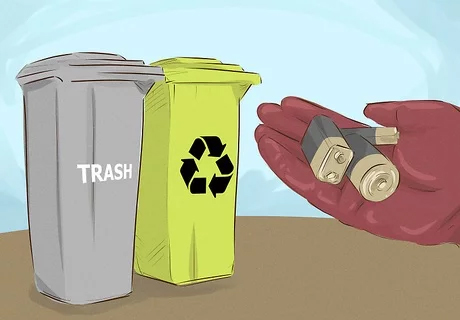Almost every home has a flashlight. Flashlights are handy and small. They are mainly used for finding things in the dark or walking around outdoors at night. Batteries power flashlights, and these batteries must be replaced once they run out. That is why in this article, we will discuss how to properly dispose of flashlight batteries. Batteries are very harmful to the environment because they contain toxic heavy metals and acids. Therefore, it is our responsibility to dispose of them properly. Let's get started!
Before we can understand how to dispose of flashlight batteries, we must understand the different types of flashlight batteries. Flashlights come in different shapes and sizes, most of which are powered by disposable batteries. These batteries come in a variety of sizes. Some batteries are also more dangerous than others. Please read on to learn more about these batteries.
► Button cell batteries. A watch battery or button cell is a small, round battery that is designed to be almost flat. It is usually about 5 to 25 mm in diameter and 1 to 6 mm high. This type of battery is used in small, lightweight, compact keychain flashlights.
► Carbon Zinc Batteries. A carbon zinc battery uses a chemical reaction to produce electricity. It provides a powerful 1.5 bolts of DC power. They were the first commercially available dry cell batteries sold on the market. It made portable flashlights possible because the batteries can work in any direction.
► Alkaline batteries. Alkaline batteries are almost identical in composition to carbon zinc batteries. It can be said to be an upgraded version of the carbon zinc battery because it can hold more energy and has a longer shelf life. Alkaline batteries provide the same voltage as carbon zinc batteries. Serious flashlight owners prefer to use these types of batteries because of their durability and functionality compared to their predecessors. For those who store batteries in situations such as emergencies or long-term crises, it is critical to extend the shelf life of the batteries.
► Rechargeable batteries. Unlike alkaline or carbon zinc, a rechargeable battery can be recharged multiple times. It costs relatively less than other costs. They are also less harmful to the environment than other batteries. However, they deplete quickly and require a power source to recharge.
► Lithium-ion batteries. Lithium-ion batteries are a rechargeable battery. This is what we see in most devices, such as smartphones and speakers. Lithium-ion batteries have a higher discharge rate and can last longer when used and handled correctly. However, lithium-ion batteries can be dangerous. tt contains flammable electrolytes that can cause fires when they overheat or fail.

As we learned in the previous section, flashlight batteries come in different sizes and contents. Therefore, it is best to be able to identify one from the other. This is crucial to understanding how to properly dispose of flashlight batteries, especially when outdoors. Let's get started!
► Alkaline batteries and zinc ion batteries. There are exemptions for these types of batteries. Alkaline and zinc ion batteries made since 1996 are made from non-hazardous materials, which means you can just throw them in the trash after use. Some people even use it in landfills, saying it won't harm the environment if it's thrown away in nature. Some states and municipalities still recommend and recommend that these batteries be considered hazardous waste. Therefore, it is best to check your state's regulations first, or to collect these batteries and take them to a designated facility.
► Rechargeable batteries. These batteries contain nickel and cadmium, which are very harmful to human health and the environment. These types of batteries must be disposed of at a hazardous waste collection site, recycling facility, or at an electrical retailer in the area.
► Lithium-ion batteries. Lithium-ion batteries should be disposed of at a hazardous waste facility or recycling facility. It can also be donated to your local appliance retailer. Some companies accept lithium-ion batteries in order to refurbish them and use them in other gadgets.
A flashlight is an important tool for people who like to be prepared for emergencies and moments of crisis. A flashlight is made so that people can see in the dark. It can also come in handy as a weapon when in danger. Every household should have a flashlight and it is our responsibility to dispose of flashlight batteries accordingly. Batteries are very harmful to the environment. It can poison water and emit fumes rather than harm humans. Learning how to dispose of flashlight batteries should be a basic knowledge for any flashlight owner.

 Ni-MH Battery C4700mAh 3.6V
Ni-MH Battery C4700mAh 3.6V Nickel Cadmium Nicd Battery Pack SC1800mAh 3.6V
Nickel Cadmium Nicd Battery Pack SC1800mAh 3.6V Ni-Cd Battery Pack D4000mAh 3.6V
Ni-Cd Battery Pack D4000mAh 3.6V Ni-Cd Battery Pack C2500mAh 3.6V
Ni-Cd Battery Pack C2500mAh 3.6V NICAD Battery Pack AA900mAh 3.6V
NICAD Battery Pack AA900mAh 3.6V LiFePO4 IFR18650 1600mAh 3.2V
LiFePO4 IFR18650 1600mAh 3.2V LiFePO4 IFR18650 1600mAh 6.4V
LiFePO4 IFR18650 1600mAh 6.4V Ni-MH Battery C4000mAh 3.6V
Ni-MH Battery C4000mAh 3.6V E-bike Battery 48V 10Ah JL-1
E-bike Battery 48V 10Ah JL-1 E-bike battery 48V 10Ah Qing Tian
E-bike battery 48V 10Ah Qing Tian